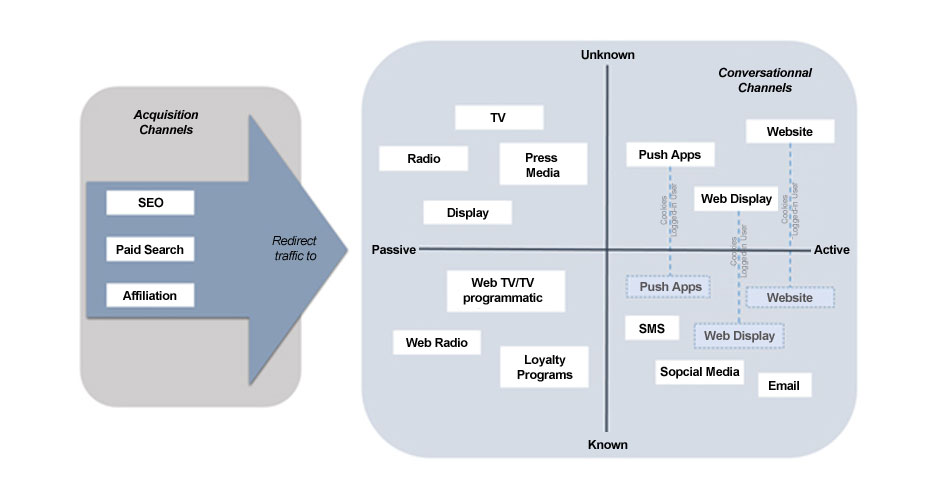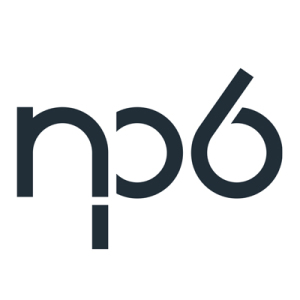ONE-TO-ONE MARKETING AUTOMATION 3/3
12 Jul 2016

Previously, we demonstrated that despite the fact that predictive marketing approaches enable a campaign’s targeting to be adapted according to its content and time of broadcast; data management becomes more complex and the optimal decision less obvious. We have seen how prescriptive approaches, from the Operational Research field, can take over to exploit through automation, the richness of predicted data while individually optimising campaign broadcasting planning. Achieving this transformation comes down to implementing a marketing automation strategy for the email channel.
If the transition from predictive to prescriptive enables automated email marketing, can we extend this logic to other channels? Is there any interest in mutualising different channels within the same environment?

Classifying marketing channels to reflect strategies
Email is a specific marketing channel with metrics, constraints, advantages and inconveniences that do not apply to other channels. Prescriptive approaches, so far discussed, will not directly apply to other channels. For each channel we will need to conceive the predictive/prescriptive combination that will be the most relevant and efficient. The qualitative study of the numerous channels a marketer has access to today is a separate topic altogether. Nonetheless, to avoid getting into detail, the best way to approach it is to identify what’s possible to do for each channel in terms of predictive and prescriptive marketing.
We must first separate marketing channels that are dedicated to acquisition (SEO, Paid Search, Affiliation...) from those dedicated to the conversation with the prospect. Acquisition works according to triggered programs enabling to redirect a more or less qualified traffic towards conversational channels. We define a conversational channel through its capacity to deliver a message to a prospect. For instance, a message has a meaningful content as opposed to a link. We are focusing here on conversational channels because they are the medium we want to automate in order to establish a relationship between the brand and the prospects. We classify them using two axes to describe their capacity to know and interact with the prospect.
The first axis shows whether the channel enables us to personally know the prospect, directly or not. These channels are capable to assign a unique and shared identifier to one specific individual which will help us finding it in other channels. Thus, channels communicating through a phone number, an email or a mail address “know” their clients; whereas those communicating to
non-logged-in entering web traffic or broadcasting to large audiences do not know them. Even if we can get a precise description of the audience, we cannot for each individual. The capacity to know the client is often done indirectly, through data cross referencing tools such as DMPs (Data Management Platform).
The second axis indicates the capacity for a channel to interact with the prospect. It is active when we detect a positive or negative reaction to a broadcast as is the case for emailing and SMS. It is passive when the channel does not permit to detect the prospect’s interest in the message as is the case for television or radio.

The previous diagram shows the classification to regroup the channels within the 2 axes discussed. The boundaries are not so hermetic as technology keeps on evolving: cookies or the user logging into a service which tracks its activity will enable us to know a prospect so far unknown. In addition, we can argue in the case of press media, television or radio that prospects are not so passive since they react using coupons or SMS. Nonetheless, the classification works in general and enables us to define predictive, then prescriptive strategies to apply in order to implement a true marketing automation approach for each channel.
One predictive/prescriptive approach per conversational channel
Let’s describe how the unknown/known and passive/active axes structure the different approaches to setup. The fact of knowing a prospect in the sense of being able to cross data to retrieve it amongst a larger volume of data, mainly enables us to attach a history log to this prospect. This prospect might have been a client in the past! Knowing your prospect enables to establish precise individual scoring. It will enable you to predict how the prospect will react to a particular channel according to what they have already done on that channel. Conversely, an unknown prospect with little or no history at all, will strongly limit the prediction potential.
In addition, the fact of having the capacity to detect a prospect’s reaction, enables us to push decisions to the individual level when looking for a campaign’s performance. Indeed, the results of a campaign are immediate and can be measured directly. Conversely, a channel where prospects are passive; it is difficult to measure the success of a campaign and it cannot be analysed solely from its performance. The decision will in this case revert to groups of prospects (an audience time range segment for TV, magazine reader’s types or entering traffic of a news website).
Each channel has its own specificities, but we can use segmentation as described previously, to propose a general trend for a predictive/prescriptive strategy according to the type of channel:
- known / active prospects: the ideal case for micro-performant marketing. The history enables powerful predictions and prescriptions can go down to individual level to exploit them to the maximum. The principles described in the previous article about email can apply to SMS or social networks.
- known / passive prospects: ideal for a highly qualified and engaged marketing audience. We have less control over the returns but the message gets to the target. Predictive anticipates target/segment potential and prescriptive enables to optimise message broadcasting. It is the same logic for the known/active prospects to the difference that we go down to cohorts of “look-alike” individuals rather than down to the individual level. Programmatic technologies address this niche.
- unknown / active prospects: the ideal case for macro-performant marketing. On these channels, the art is to learn what communication to push without knowing to whom we are pushing it to. Here, the most efficient approaches natively combine predictive and prescriptive within a unique Artificial Intelligence which dynamically learns and decides. The algorithms look for the best compromise between exploration (to learn what campaign works best and on what medium web/app) and exploitation (to use knowledge and push the best campaign). The decision is never taken to the individual level but the AI looks for a global performance level.
- unknown / passive prospects: the ideal case for marketing to a large audience. We only have a global idea on the campaign’s target and measuring performance is limited. Predictive quantifies the success of the large segments within the channel (this TV channel, this radio station), and prescriptive is reduced to its most simplistic expression: to choose the best segment without blowing the budget.
Therefore, predictive and prescriptive chain up or intertwine, more or less differently, more or less powerfully; according to the opportunities and the limits of the channel. Clearly, the cases where channels or prospects are unknown and passive pose a real limit to applying a marketing automation logic that doesn’t seem to have much to offer. To go beyond this obstacle, there is one last essential step that will be at the centre of tomorrow’s marketing automation tools.
Marketing channel unification
So far, we have demonstrated how to establish a declination of predictive/prescriptive approaches to marketing channels. If this plea for channel automation, we are still not seeing an interest in regrouping them within the same environment since they are able to operate independently one from another as is often the case today. However, we totally omit the strong connexions that exist between these channels. Media planning professionals are constantly faced with the estimation of these interactions in regards to the real impact of a channel on sales; and considering this impact can be indirect. These integrations are the missing levers to obtain a unified view of all channels and to act on them globally and not separately. In this context, integrating channels where prospects are unknown/passive makes sense because these media (TV, Radio, Press Media) are known to have a strong impact on other marketing channels! Therefore, we can see channels as a multitude of levers at the disposal of marketing to optimise sales. But to be useful, we must add a prescriptive layer, before the automation of each channel, to help conceive a global, multi-channel plan of action over time.

Predictive in the sense we usually perceive it meets its limits and it is towards research studies that we will prefer to turn to understand and model the complexed interactions that exist between the channels. Indeed, when we do not know nor detect prospects, only research studies have the ability to collect enough qualitative data to conceive descriptive models of these interactions such as Bayesian networks. These models will then be useful to inform prescriptive in order to suggest the best way to activate marketing campaigns.
And human beings in all that? What will Marketing look like if machines go as far as deciding on planning and scheduling campaigns? We must not give more powers to algorithms than they already have. They are far better at calculating predictions and optimising configurations but they only know how to work in a defined, limited and short termed environment. Human beings outsmart machines on innovation, abstract thinking, on renewing approaches and long term vision. Algorithms are an opportunity if they do exactly what they are good at, no more no less. The technical challenges behind the implementation of unified multi-channel marketing automation are numerous. But the true challenge that will determine the success of tomorrow’s marketing automation resides in finding the boundary between men and machines where synergy is optimal.
First published on the 20th of January 2016
This article is the third and last part of a series of 3 articles
Cédric Hervet, Operation Research Director at SOCIO (NP6 Group)
Part1: Predictive marketing within emailing is the milestone to one-to-one marketing
Part2: Prescriptive email marketing, the automated and optimised one-to-one

Please login to comment.
Comments